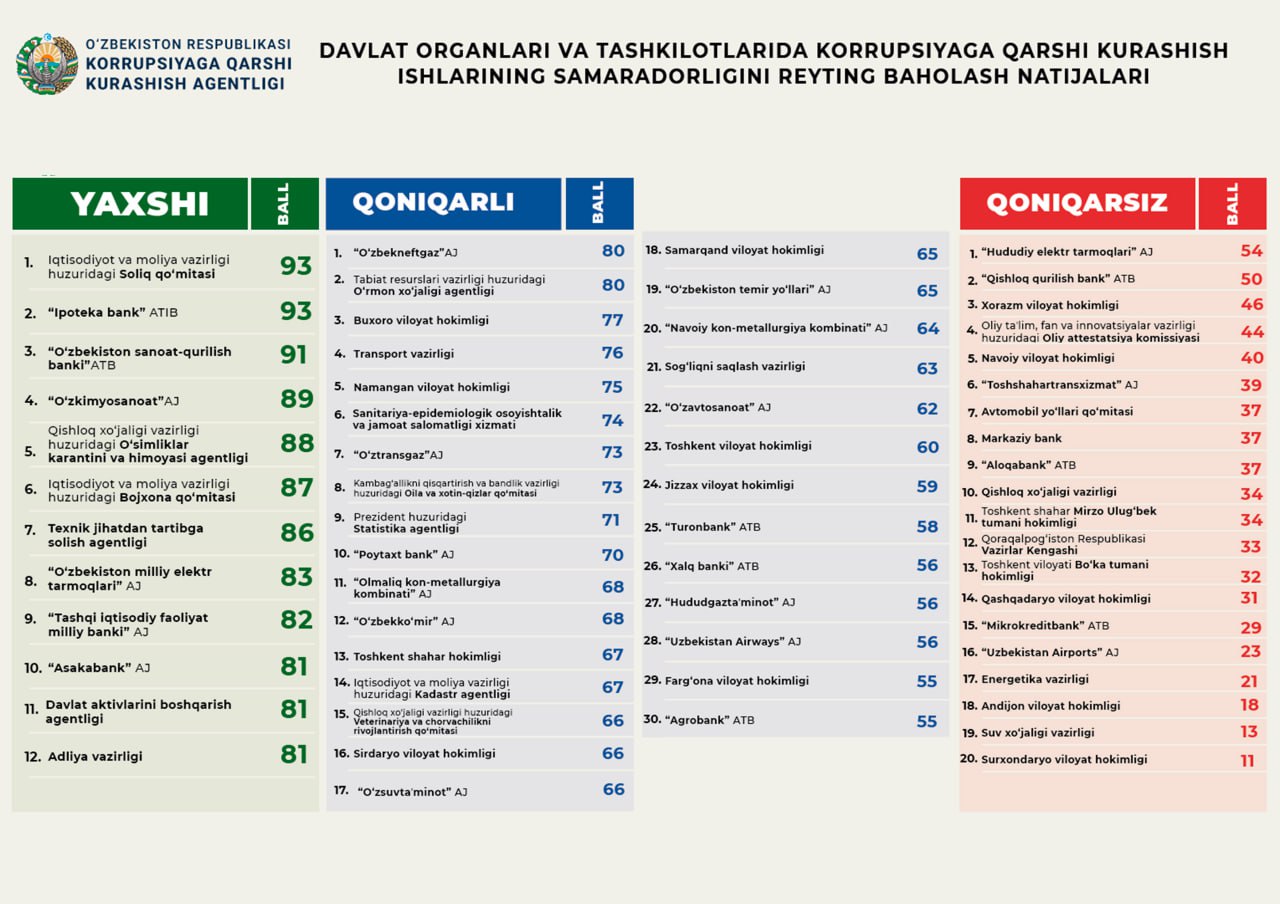The Anti-Corruption Agency has conducted the assessment of the effectiveness of anti-corruption work in government bodies and organizations, including local executive authorities.
For reference: According to the Resolution of the President of the Republic of Uzbekistan No. RP-81 of January 12, 2022, the assessment is carried out on the basis of 29 special indicators through E-Anticor.uz electronic platform.

In order to ensure the objectivity of the results of the rating assessment, an Expert Group was formed from representatives of civil society institutions.
The effectiveness of anti-corruption work of 62 state organizations was assessed on a scale from 0 to 100 points. 12 organizations received ‘good’ scores (81-100 points), the anti-corruption work of 30 organizations were rated as ‘satisfactory’ (55-80 points) and 20 organizations received ‘unsatisfactory’ scores (below 55 points).
The results of the analysis showed the presence of a number of shortcomings in the anti-corruption efforts in the activities of government bodies and organizations.
Insufficient personal initiative of leaders in the fight against corruption, the lack of an accountability mechanism and attention to the implementation of an effective anti-corruption system led to an unsatisfactory assessment of the performance of some government bodies and organizations.
In particular, the internal anti-corruption control system has been inefficiently implemented in the Surkhandarya regional administration (11 points), the Ministry of Water Resources (13 points), the Andijan regional administration (18 points) and the Ministry of Energy (21 points).
Despite the fact that the anti-corruption work of some government organizations was recognized as ‘satisfactory’, they failed in monitoring the implementation of assigned tasks.
At the same time, these organizations have not created an effective system of control over the continuous implementation of established anti-corruption requirements.
The effectiveness of anti-corruption work of 12 government bodies and organizations was rated as ‘good’. The systematic implementation of anti-corruption measures in these organizations was noted. In particular, specific and targeted measures were taken to assess corruption risks and minimize them, and the heads of organizations set a personal example in the fight against corruption. For example, the Customs Committee (87 points) introduced the Corruption Risk Management automated information system, established a system for evaluating the performance of all employees using artificial intelligence and creating an online ‘portrait’ of an employee with a high level of risk.
In addition, internal anti-corruption control units have been created in all subordinate organizations of the Tax Committee, and an effective mechanism for identifying and reducing corruption risks has been introduced in commercial banks with good results, and awareness-raising work is regularly carried out to prevent corruption among employees.
The rating system, along with effective control of the tasks set in the field of combating corruption, made it possible to strengthen the environment of healthy competition in the field and further increase the responsibility of the heads of government bodies and organizations.

Based on the results of the assessment, the experience of government organizations that received a ‘good’ assessment will be made public.
Organizations rated ‘satisfactory’ will be given recommendations for further improvement of their anti-corruption activities.
In organizations that received an ‘unsatisfactory’ rating, an action program will be developed aimed at eliminating the identified shortcomings in the fight against corruption and improving their activities in this track, and the reports of the heads of these organizations will be heard quarterly at meetings of the National Anti-Corruption Council of the Republic of Uzbekistan.
The results of the rating assessment were submitted to the National Council.
Press Office
The Anti-Corruption Agency







